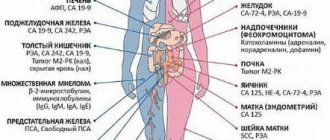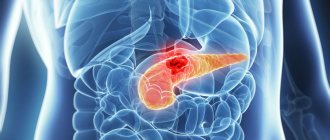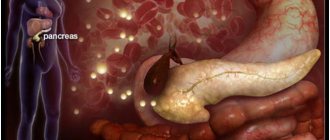- Ultrasound machine
Ultrasound machine
SAMSUNG SONOACE R7
Class:
Expert (installation year 2019)
What is included in the cost of ultrasound:
Ultrasound diagnostics, interpretation of images, written diagnostic report
Sign up
Anatomy of the pancreas
Normally, the pancreas in an adult weighs about 80 grams, has a length of 14-18 cm, a width of about 3-9 cm and a thickness of approximately 2-3 cm.
The pancreas is located in the retroperitoneal space, in the epigastric region, at the level of the first and second lumbar vertebrae, and has an oblong shape, approximately located transverse to the midline. For various pathologies determined by ultrasound, it can have a ring-shaped, spiral, split shape, or have doubled individual parts, an additional lobule.
The main parts of the pancreas are the head, the body in the middle, and the tail, on the far left. The longest part of the pancreas is located to the left of the midline, and the tail near the splenic muscle is usually slightly above the head. The rather complex shape of the pancreas and its close location to nearby structures can make it difficult to recognize, but experienced ultrasound physicians are able to use surrounding structures to determine some of the boundaries of the pancreas. For example, the head and body of the pancreas are located below the liver, in front of the inferior vena cava and the aorta behind the distal part of the stomach. On the far left, the tail of the pancreas is located below the spleen and, accordingly, above the left kidney.
The pancreas has the structure of small lobules that produce enzymes for digestion, and pancreatic islets that secrete an important hormone, insulin, into the bloodstream. It is he who helps provide energy to every cell of the human body due to its active participation in carbohydrate metabolism. Digestive enzymes or pancreatic juice take part in the digestion process and are excreted into the duodenum.
How is the research going?
First, the patient lies on his back, then he turns on his left side. In this position, the tail of the gland is scanned. After this, he turns on his right side. To examine the condition of the head and body of the gland, the doctor asks the patient to take a semi-sitting position.
As landmarks for detecting the pancreas, the sonologist uses the aorta with the inferior vena cava, superior and inferior mesenteric arteries, etc. There is a special program to determine the size of the organ. Even if all the indicators do not deviate from the norm, the doctor provides a detailed breakdown of the data in the conclusion.
The density of pancreatic tissue (echogenicity) depends on the age and body weight of the patient. Over the years, it decreases and acquires signs of hyperechogenicity. Normally, the structure of the gland is homogeneous. Proper preparation facilitates good viewing of all parts of the organ during the examination.
Indications for ultrasound
Ultrasound examination of the pancreas is usually included in a comprehensive examination of the abdominal organs. After all, it is closely related to the functions of other internal organs, mainly the liver. The indication for research is any pathological condition of the digestive system. Many diseases can be asymptomatic, so once a year it is necessary to conduct an ultrasound examination of the abdominal cavity for early detection of many diseases.
The most common conditions for which an ultrasound is recommended:
- prolonged or periodic pain, discomfort in the upper abdomen or left hypochondrium;
- tension in the anterior abdominal wall or local pain in the epigastric region, which was detected by palpation;
- frequent bloating (flatulence), nausea and vomiting that does not provide relief;
- diarrhea (stool disorders), constipation, detection of undigested parts of food in the stool;
- presence of low-grade fever for a long time;
- when observing the patient's yellowness of the skin and mucous membranes, deviations of laboratory parameters from the norm;
- with a sharp increase in blood sugar levels and an unreasonable decrease in body weight;
- after an x-ray of the abdominal organs has been performed and changes in size, shape, structure, distortion of contours have been identified, and pneumatosis of the pancreas has been detected;
- if you suspect the presence of a cyst, tumor, hematoma, stones, or abscess in the gland.
Mandatory use for abdominal injuries and elective surgeries is indicated.
Pathological changes
- An abscess (abscess) of the pancreas looks like a pocket or bag filled with sequesters and heterogeneous fluid. As the patient's body position changes, the level of fullness changes.
- Acute or chronic pancreatitis, causing changes in the structure of a diffuse or focal nature. At the same time, the tissue density is reduced, the contours of the organ are not clear. The size of the gland and its ducts is higher than normal. Based on these changes, the doctor diagnoses pancreatitis.
- The appearance of necrotic foci and cysts further provokes the complete melting of pancreatic tissue (pancreatic necrosis). This appears as poorly structured hypoechoic areas.
- One of the consequences of pancreatic necrosis is the formation of many purulent abscesses, which, merging, form large areas of pus and sequestration.
- False cystic formations on the screen look like anechoic cavities filled with fluid.
- Tumors on ultrasound look like round or oval formations of low density and heterogeneous structure, abundantly covered with a network of blood vessels. If cancer is suspected, all parts of the gland must be examined very carefully. If the focus of a malignant tumor is in the head, then the sign will be jaundice. Ultrasound data also allows you to diagnose the type of cancer.
Preparing for the study
Ultrasound of the pancreas can be performed both routinely and as an emergency in acute conditions. When carrying out a planned procedure, it is necessary to follow some rules and prepare for this procedure. After all, the most problematic thing during ultrasound examination is the presence of air in adjacent hollow organs. It is this that can interfere with a detailed study, distort visualization and contribute to the incorrect diagnosis of the patient. Doctors recommend undergoing pancreatic diagnostics, preferably in the morning. After all, it is during this half of the day, following all the rules and recommendations, that you can get the most accurate results.
During routine diagnostics, it is necessary to follow a gentle diet three days before the date of the procedure. It is advisable to exclude foods that cause fermentation and bloating in the intestines, and do not consume foods rich in fiber and whole milk. The day before the test, it is recommended to take a laxative to cleanse the stomach and intestines. For twelve hours before the planned ultrasound examination, you must refrain from eating and drinking water, avoid taking medications, and prohibit smoking. Carbonated drinks should not be consumed as they cause excess gas production, which may affect ultrasound results and imaging.
In case of emergency indications for an ultrasound scan of the pancreas, the patient does not need preparation. But this can reduce the information content to approximately 40%.
Method of performing ultrasound of the pancreas
Sonography of the pancreas is a completely painless, highly informative and accessible procedure for most patients. In addition, it takes very little time - about ten minutes. It is necessary to free the abdominal area from clothing; it is on this area that the doctor will apply a special gel, called mediagel, and conduct an examination using an ultrasound probe. The patient should lie quietly, initially on his back, and later, with the permission of the doctor, turn on his right and left side, for a comprehensive examination of the pancreas. An ultrasound diagnostic doctor examines the gland while holding the breath while inhaling to the maximum and while the patient is breathing calmly. He must also decipher the diagnostic results and give the patient a complete report and pictures of the pancreas.
During this procedure, the position of the pancreas in relation to the vessels and spinal column, the structure of the pancreatic ducts and the gland itself, shape and size are studied.
The doctor will immediately be able to see the compaction or swelling of the gland, the presence of calcifications, the inflammatory process, the presence of pathological formations, cysts and pseudocysts.
If the inflammatory process has already been present for a long time, then the pancreas can significantly decrease in size, scar tissue can grow, fat deposits can increase, the capsule of the internal organ thickens, and the echogenicity of the gland increases.
Ultrasound results for acute and chronic pancreatitis
Ultrasound diagnostics during a person’s initial request for medical help - in an acute moment of pancreatitis, will be an informative confirmation of the doctor’s diagnosis.
At the conclusion of the ultrasound, the specialist will indicate the main signs of the inflammatory process:
- the size of the pancreatic structure is slightly increased when compared with the age norm;
- echogenicity – reflection of ultrasonic waves from an organ, enhanced;
- the contours of the gland are uneven, the clarity is changed;
- the ducts of the pancreas are dilated, their walls are poorly visible;
- additional formations are visible - cysts, areas of tissue decay, abscess, fluid accumulations.
In chronic pancreatitis, ultrasound changes will be somewhat different:
- the contours of the organ are finely lumpy, sometimes even jagged;
- ducts – persistently dilated;
- echogenicity – reduced;
- sizes – significantly increased, then gradually decreased.
Chronic pancreatitis is accompanied by sclerosis and fibrosis of the organ tissue - healthy cells are replaced by connective tissue elements. The ultrasound signal is reflected less well from these areas.
Normal pancreas values
On an ultrasound scan, your doctor will normally see a “sausage-like”, S-shaped pancreas. It will have clear and even edges, a homogeneous, fine-grained or coarse-grained structure, the vascular pattern will be visible on the screen without deformation, the central duct of the gland - the Wirsung duct will not be enlarged (normally - 1.5-2.5 millimeters). It looks like a thin hypoechoic tube; it can decrease in diameter in the tail and be larger in the region of the head of the gland.
The size of this organ varies depending on the age, body weight and body fat of patients. The older the person, the less iron and the more echogenic it will be during scanning. A study was conducted in which 50% of people had increased echogenicity of the pancreas, and in children, on the contrary, it was decreased. An indicator of a healthy pancreas is its uniform structure.
In an adult, the size of the head of the gland can be from 18 to 30 millimeters, the body - from 10 to 22 millimeters, and the tail - from 20 to 30 millimeters. In children, everything will depend on the height, weight and age of the child: the body is from 7 to 14 mm, the head of the gland is from 12 to 21 mm, and the tail is from 11 to 25 mm.
Deviations in the structure of the organ and their possible causes
An acute inflammatory process according to ultrasound manifests itself in an increase in size, as well as a decrease in the echo density of the gland itself - due to tissue swelling.
Additional changes:
- pronounced heterogeneity of structure;
- dilation of the main duct of the gland;
- swelling in surrounding tissues;
- accumulation of fluid - in or near an organ;
- the formation of additional formations – pseudocysts – is possible.
Repeated acute inflammations later lead to chronic pathological changes in the pancreas structure. Signs indicate this:
- reduction in size;
- blurred contours, blurred isthmus;
- replacement of healthy cells with fatty elements;
- change in echogenicity.
In case of persistent pain and no effect from the treatment, the doctor also prescribes ultrasound monitoring to exclude oncological changes in the organ.
Signs of a tumor:
- focal defect in one of the lobes – mixed echogenicity;
- a clear contour of the additional inclusion with simultaneous deformation of the outer wall of the gland;
- persistent dilation of the duct;
- enlargement of nearby lymph nodes.
The final diagnosis is made by the attending physician, and not by an ultrasound specialist. Therefore, with the result of the diagnostic procedure, a person must consult his doctor.
Ultrasound of the pancreas for various pathologies
For pancreatitis
Pancreatitis is an inflammation of the pancreas and can be easily detected using an ultrasound scan. After all, it is the acute onset of this disease that greatly affects the structure, size, and structure of the gland tissues. The disease occurs in several stages and each stage, of course, will have its own characteristics.
Pancreatitis can be total, focal, segmental. They can be distinguished from each other by determining the echogenicity of the organ. A change in echogenicity can occur both in the entire gland and only in a certain part of it.
Initially, the pancreas will actively increase in size, the contours will be distorted, and the central duct will expand. As the gland enlarges, compression of large vessels will occur and the nutrition of neighboring organs will be disrupted, with an increase in echogenicity in them. The liver and gall bladder will also enlarge.
In the last stages of this serious disease, an experienced doctor will be able to consider when the necrotic stage will progress, organ tissue will disintegrate, and there may be the presence of pseudocysts or foci with abscesses in the area of the walls of the abdominal cavity.
When is an ultrasound of the gallbladder prescribed?
The gallbladder is one of the organs of the abdominal cavity, pear-shaped, small in size, located directly under the liver. Ducts connect the gallbladder to the liver. An ultrasound of the gallbladder is necessary for diseases and symptoms:
- pain in the liver area;
- cholelithiasis;
- abnormalities in the development of the organ and ducts;
- inflammatory diseases (cholecystitis);
- polyps;
- neoplasms of any type;
- dropsy.
If you have symptoms of at least one of the above diseases, we recommend that you consult a doctor and undergo an ultrasound of the gallbladder. If you have symptoms indicating diseases of this organ, then an ultrasound of the gallbladder ducts will help find the cause of your concerns. Conclusion An ultrasound will show possible disruptions in development, neoplasms, and more.
Preparing for an ultrasound of the gallbladder: features
The main obstacle to performing an ultrasound of the abdominal organs can be gases in the intestines. Therefore, before an ultrasound scan of the gallbladder, you need to limit yourself to the following:
- A few days before the examination, you need to exclude foods that contribute to the development of flatulence from your diet. Among them: vegetables and fruits rich in fiber, bread made from dark grains and sweets.
- Is it possible to eat before an ultrasound of the gallbladder? No, ultrasound is performed on an empty stomach, that is, 6-12 hours before the procedure you cannot eat anything, the last meal should be satisfying, but not aggravating.
- A week before the test, you should stop drinking alcohol and eating fatty foods.
The patient must know how to prepare for an ultrasound of the gallbladder. The procedure is quick and unnoticed, and there are no contraindications to ultrasound, therefore, ultrasound of the abdominal cavity can be performed even on children.










